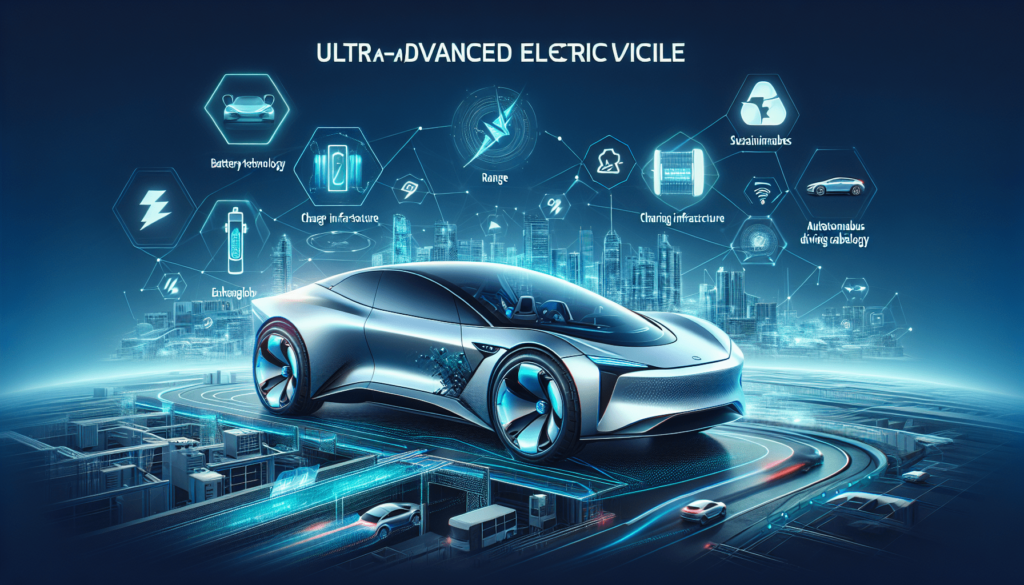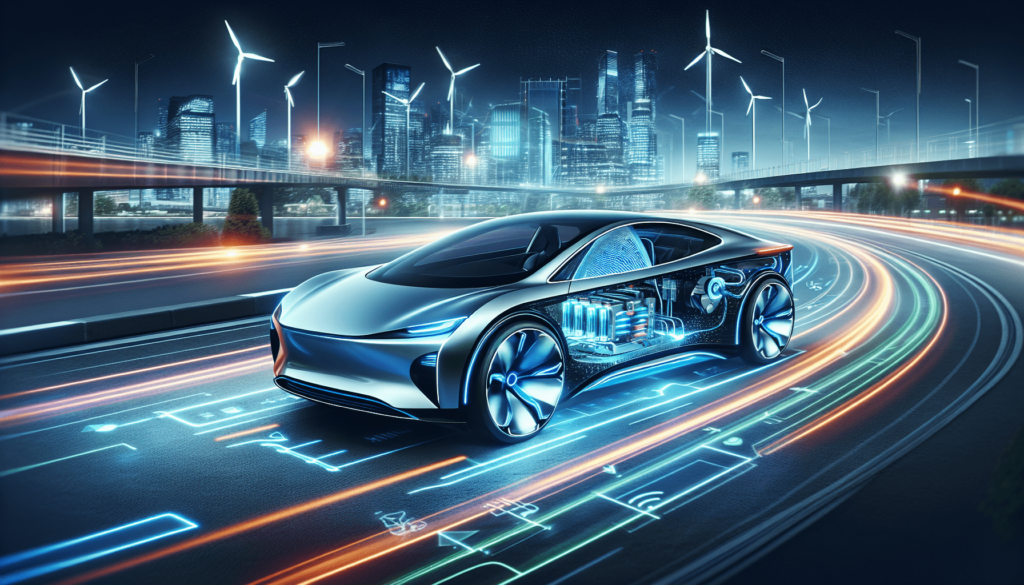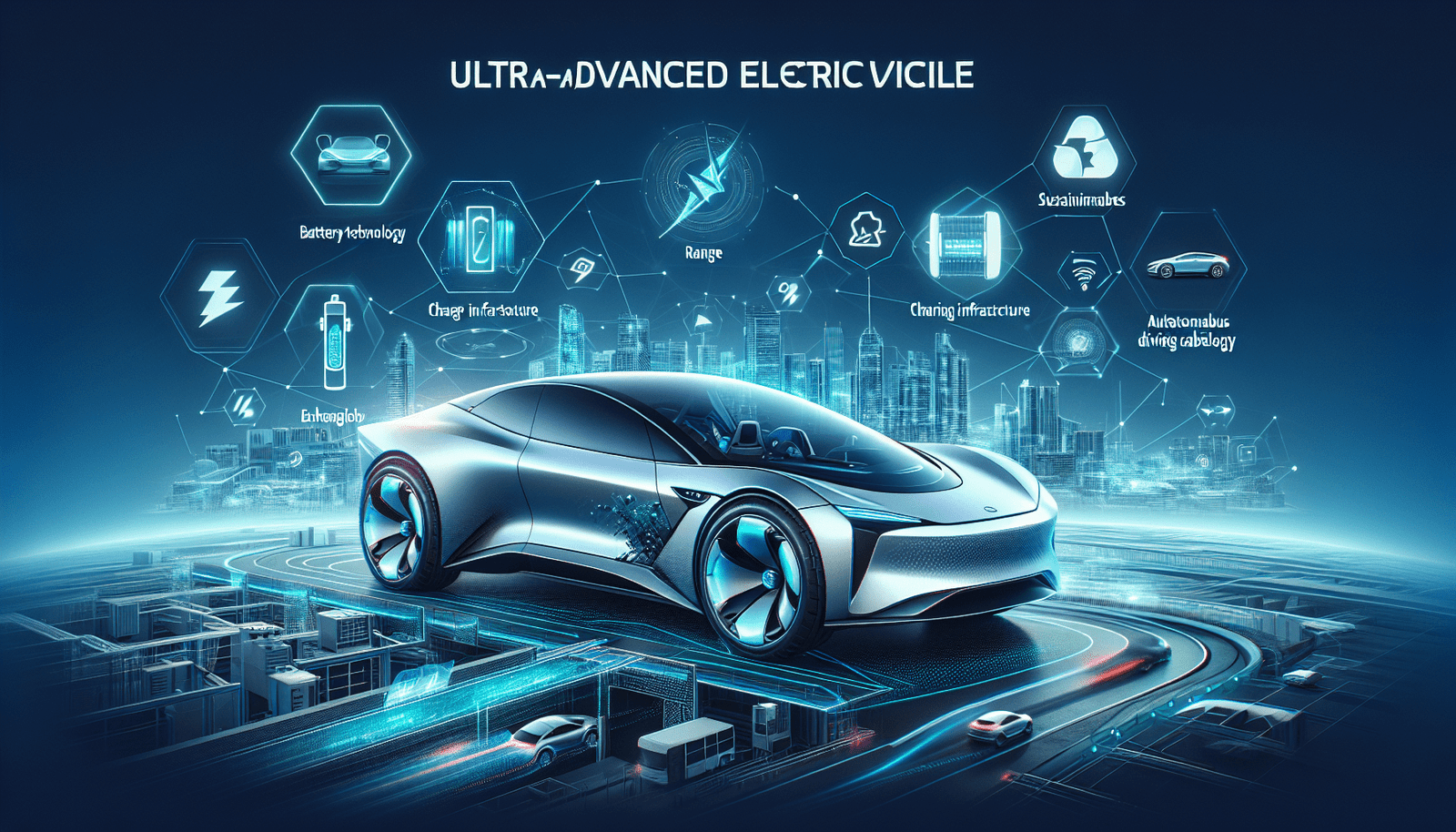Electric vehicles have been gaining traction in recent years, with more and more people opting for these eco-friendly alternatives. But what exciting trends can we expect in electric vehicle design and technology? From advanced battery technology to sleek and aerodynamic designs, the future of electric vehicles is looking brighter than ever. Get ready to explore the latest breakthroughs and innovations that are set to revolutionize the way we drive and shape the future of transportation.

1. Lightweight Materials
Increased use of carbon fiber composites
One of the emerging trends in electric vehicle design and technology is the increased utilization of carbon fiber composites. Carbon fiber composites are incredibly lightweight and possess a high strength-to-weight ratio. These materials enable the design of electric vehicles that are not only lighter, but also offer improved performance and efficiency. By incorporating carbon fiber composites into the vehicle’s structure, manufacturers can reduce overall weight, thereby increasing the range of the vehicle and improving its energy efficiency.
Development of advanced aluminum alloys
Another trend in electric vehicle design is the development of advanced aluminum alloys. Aluminum alloys have long been utilized in the automotive industry due to their lightweight nature and excellent formability. However, advancements in aluminum alloy technology have led to the manufacturing of materials that offer improved strength and durability while remaining lightweight. By utilizing advanced aluminum alloys in electric vehicle construction, manufacturers can achieve a balance between weight reduction and structural integrity, contributing to increased efficiency and improved performance.
Integration of high-performance polymers
The integration of high-performance polymers is yet another significant trend in electric vehicle design. High-performance polymers, such as reinforced plastics, offer excellent mechanical properties, including high strength, stiffness, and impact resistance. These materials allow for the creation of lightweight components without compromising on durability and safety. By incorporating high-performance polymers into the design of electric vehicles, manufacturers can reduce weight and enhance performance, ultimately leading to increased efficiency and range.
2. Battery Technology
Advancements in lithium-ion batteries
The advancements in lithium-ion battery technology have been instrumental in the development of electric vehicles. Lithium-ion batteries offer high energy densities, allowing for increased range and improved performance. Continuous research and development efforts have resulted in advancements that have enhanced the safety, charging speed, and overall lifespan of lithium-ion batteries. This trend enables electric vehicle manufacturers to offer vehicles with longer ranges, shorter charging times, and improved reliability.
Solid-state batteries for improved safety and energy density
Solid-state batteries are an emerging technology that holds great promise for the electric vehicle industry. Unlike traditional lithium-ion batteries, solid-state batteries utilize solid electrolytes instead of liquid electrolytes. This design offers several advantages, including improved safety, increased energy density, and faster charging times. By utilizing solid-state batteries, electric vehicles can offer higher ranges, shorter charging times, and enhanced safety features, making them more attractive to consumers.
Exploration of alternative battery chemistries
Researchers and manufacturers are constantly exploring alternative battery chemistries to further improve electric vehicle technology. This includes lithium-sulfur batteries, which offer higher energy densities than lithium-ion batteries, and sodium-ion batteries, which are more abundant and cost-effective. By exploring and investing in alternative battery chemistries, the electric vehicle industry can continue to enhance the performance and efficiency of electric vehicles, ultimately leading to more sustainable transportation options.
3. Range Improvement
Enhancement of energy storage capacity
One of the key focuses in electric vehicle design is the enhancement of energy storage capacity. By increasing the energy storage capacity of electric vehicles, manufacturers can extend the range that vehicles can travel on a single charge. This is achieved through advancements in battery technology, such as increased energy densities and improved charging efficiency. As energy storage capacity improves, electric vehicles become more practical and convenient for everyday use, attracting a wider consumer base.
Development of fast-charging solutions
To address the issue of long charging times, the development of fast-charging solutions is a crucial trend in electric vehicle design. Fast-charging technology allows drivers to recharge their electric vehicles in significantly less time, making electric vehicles more convenient and practical for long-distance travel. Advancements in charging infrastructure and the adoption of standardized fast-charging protocols contribute to the expansion of fast-charging capabilities, improving the usability and appeal of electric vehicles.
Implementation of efficient regenerative braking systems
Regenerative braking systems are being increasingly implemented in electric vehicles to improve energy efficiency and extend the vehicle’s range. These systems capture and convert kinetic energy generated during braking into electrical energy, which is then stored in the vehicle’s battery. By utilizing regenerative braking systems, electric vehicles can recover and reuse energy that would have been wasted in conventional internal combustion engine vehicles. This leads to improved energy efficiency, increased range, and reduced reliance on external charging infrastructure.
4. Autonomous Capabilities
Integration of self-driving technologies
The integration of self-driving technologies is a significant trend in electric vehicle design. Electric vehicles provide an ideal platform for autonomous driving due to their electric drivetrain and advanced computer systems. Self-driving technologies, such as advanced sensors, cameras, and artificial intelligence algorithms, enable electric vehicles to navigate and operate without human intervention. This not only enhances convenience and safety but also paves the way for innovative transportation models, including ride-sharing and autonomous fleet management.
Development of advanced driver assistance systems (ADAS)
Advanced driver assistance systems (ADAS) are becoming increasingly prevalent in electric vehicles. These systems utilize a combination of sensors, cameras, and automated controls to assist drivers in various aspects of vehicle operation. ADAS features, such as lane-keeping assist, adaptive cruise control, and automated emergency braking, enhance the safety and convenience of electric vehicles. Furthermore, ADAS technologies lay the foundation for future autonomous driving capabilities, making electric vehicles more versatile and appealing to consumers.
Sensor and camera advancements for enhanced perception
To enable autonomous capabilities and advanced driver assistance systems, sensor and camera advancements are crucial in electric vehicle design. Sensors such as LiDAR (Light Detection and Ranging) and radar enable precise mapping, object detection, and distance measurement. Similarly, high-resolution cameras provide essential visual information for accurate perception and decision-making. Continued advancements in sensor and camera technology contribute to safer and more efficient electric vehicles, fostering the growth of autonomous transportation.

5. Connectivity and Intelligent Systems
Integration of smart features and internet connectivity
Electric vehicles are increasingly incorporating smart features and internet connectivity to enhance the user experience. Connectivity enables features such as remote vehicle monitoring and control, over-the-air software updates, and integration with smart home devices. With internet connectivity, electric vehicle owners can remotely access vehicle information, monitor charging status, and even precondition the vehicle’s interior temperature. This trend provides greater convenience, control, and customization options for electric vehicle users.
Enhanced vehicle-to-vehicle (V2V) communication
Vehicle-to-vehicle (V2V) communication is an emerging trend that enables electric vehicles to communicate with each other in real-time. Through V2V communication, vehicles can share information such as their speed, location, and intended direction of travel. This technology enhances safety by enabling vehicles to autonomously coordinate movements and avoid potential accidents. Additionally, V2V communication can optimize traffic flow, reduce congestion, and improve overall transportation efficiency.
Implementation of artificial intelligence for predictive analytics
Artificial intelligence (AI) technologies are being implemented in electric vehicles to enable predictive analytics. By analyzing vast amounts of data, AI algorithms can anticipate user preferences, optimize vehicle performance, and predict maintenance needs. For example, AI can learn an individual’s driving habits and adjust the vehicle’s powertrain for optimal efficiency. Furthermore, AI-powered predictive analytics can detect potential failures or maintenance requirements, allowing for proactive servicing and minimizing downtime. The incorporation of AI enhances the overall intelligence and adaptability of electric vehicles, improving the user experience.
6. Design and Aerodynamics
Streamlined and futuristic exterior designs
Electric vehicle design is characterized by streamlined and futuristic exterior designs. The absence of an internal combustion engine allows electric vehicle designers to reimagine the traditional vehicle silhouette. Electric vehicles often feature sleek lines, aerodynamic profiles, and unique design elements that give them a distinct and modern appearance. This trend not only contributes to improved aerodynamics but also conveys a sense of sustainability and innovation, attracting consumers who appreciate cutting-edge design.
Efficient aerodynamic enhancements
To maximize energy efficiency and range, electric vehicles incorporate efficient aerodynamic enhancements. These include features such as active grille shutters, aerodynamically optimized wheels, and contoured body panels. By minimizing drag and reducing turbulence, efficient aerodynamics increase the vehicle’s efficiency by reducing energy losses and improving overall performance. Electric vehicles with excellent aerodynamics require less energy to overcome air resistance, resulting in extended range and increased overall efficiency.
Use of virtual reality for design visualization
Virtual reality (VR) technology is revolutionizing the design process of electric vehicles. Designers utilize VR tools to visualize and test various design concepts and features in a virtual environment. This enables them to evaluate the aesthetics, ergonomics, and functionality of a vehicle before physical prototypes are built. VR technology saves time and resources by allowing designers to iterate and refine designs digitally, leading to more efficient and accurate design processes. By leveraging VR technology, electric vehicle manufacturers can create compelling and visually stunning vehicles while reducing development costs.
7. Sustainable Manufacturing Processes
Adoption of eco-friendly materials and production methods
Electric vehicle manufacturers are increasingly adopting eco-friendly materials and production methods to reduce their environmental impact. This involves utilizing recycled and bio-based materials, such as recycled plastics and natural fibers, in vehicle construction and employing sustainable manufacturing practices that minimize waste and energy consumption. By embracing sustainable materials and production methods, electric vehicle manufacturers contribute to a more circular economy and reduce their carbon footprint.
Reduction of carbon footprint in manufacturing
Reducing the carbon footprint in the manufacturing of electric vehicles is a significant trend. Manufacturers are actively working to minimize greenhouse gas emissions during the production process by adopting renewable energy sources, improving energy efficiency, and implementing carbon offset programs. This commitment to reducing the carbon footprint ensures that the environmental benefits of electric vehicles extend beyond their usage phase, making them a more sustainable transportation option overall.
Implementation of recycling and circular economy principles
To further enhance sustainability, electric vehicle manufacturers are implementing recycling and circular economy principles. This includes designing vehicles with recyclability in mind, utilizing recyclable materials, and establishing recycling programs for end-of-life vehicles. Moreover, the implementation of circular economy principles focuses on extending the life cycle of electric vehicle components through remanufacturing and reusing. By embracing recycling and circular economy practices, the electric vehicle industry supports resource conservation and minimizes waste generation.
8. Electrification of Commercial Vehicles
Development of electric trucks and buses
The electrification of commercial vehicles is a growing trend that offers significant environmental and economic benefits. Manufacturers are developing electric trucks and buses that offer zero-emission transportation solutions for goods and passengers. Electric trucks and buses reduce greenhouse gas emissions, noise pollution, and dependence on fossil fuels. With advancements in battery technology and charging infrastructure, electric commercial vehicles are becoming more viable options for sustainable transportation.
Integration of charging infrastructure for commercial fleets
To accommodate the electrification of commercial vehicles, the integration of charging infrastructure for commercial fleets is crucial. Electric vehicle charging stations are being installed in strategic locations, such as depots and distribution centers, allowing commercial vehicles to charge efficiently. Rapid-charging solutions are also being implemented to reduce downtime and ensure a seamless operation for commercial fleets. The integration of robust charging infrastructure supports the widespread adoption of electric commercial vehicles, paving the way for a cleaner and more sustainable transportation industry.
Implementation of electrified logistics solutions
In addition to electric trucks and buses, the implementation of electrified logistics solutions is an emerging trend in the commercial vehicle sector. This includes the utilization of electric delivery vans, cargo bikes, and autonomous transport systems for last-mile delivery. By electrifying logistics operations, companies can reduce emissions, decrease operating costs, and improve the sustainability of their supply chains. The implementation of electrified logistics solutions aligns with the increasing emphasis on sustainable business practices and addresses the environmental impact of commercial transportation.
9. Energy Efficiency and Optimization
Improvement of powertrain efficiency
Electric vehicle manufacturers are constantly striving to improve powertrain efficiency. This involves enhancing the efficiency of electric motors, drivetrains, and power electronics. Through advancements in motor design, power electronics control, and regenerative braking systems, manufacturers can increase the overall efficiency of electric vehicles. Improving powertrain efficiency results in reduced energy consumption, longer range, and enhanced performance, ultimately making electric vehicles more attractive to consumers.
Integration of energy-saving technologies
Energy-saving technologies are becoming increasingly prevalent in electric vehicle design. These technologies include energy-efficient HVAC (Heating, Ventilation, and Air Conditioning) systems, LED lighting, and intelligent power management systems. By integrating energy-saving technologies, electric vehicles can optimize energy usage, minimize losses, and extend battery life. This improves overall energy efficiency, enhances the range of electric vehicles, and lowers operating costs.
Optimization of vehicle performance through data analysis
Data analysis plays a vital role in optimizing vehicle performance in electric vehicles. Manufacturers collect data on various vehicle parameters, such as energy consumption, driving patterns, and battery performance, to analyze and optimize vehicle performance. By leveraging data analysis techniques, manufacturers can identify areas for improvement, fine-tune powertrain settings, and develop more accurate range predictions. The optimization of vehicle performance through data analysis ensures that electric vehicles deliver optimal efficiency, range, and reliability.
10. Enhancing User Experience
Development of interactive and intuitive infotainment systems
The development of interactive and intuitive infotainment systems is a key trend in electric vehicle design. Electric vehicles offer advanced infotainment systems that provide seamless integration with smartphones, navigation services, and digital assistants. These systems offer personalized user interfaces, voice control, and high-quality audiovisual capabilities, enhancing the overall user experience. The development of interactive and intuitive infotainment systems ensures that electric vehicle occupants have access to cutting-edge entertainment, communication, and vehicle control features.
Integration of advanced driver customization options
Electric vehicles increasingly provide advanced driver customization options to cater to individual preferences. From adjustable seating positions to personalized instrument clusters and driving modes, electric vehicles offer a high degree of customization. This trend allows drivers to create a personalized driving experience and optimize vehicle settings for comfort, performance, and energy efficiency. The integration of advanced driver customization options enhances the overall user experience and adds a sense of exclusivity to electric vehicles.
Implementation of user-friendly smartphone applications
Electric vehicle manufacturers are implementing user-friendly smartphone applications that provide seamless connectivity and control. These applications allow users to remotely monitor charging status, schedule charging sessions, and precondition the vehicle’s interior temperature. Additionally, smartphone applications provide real-time vehicle information, location tracking, and even remote vehicle diagnostics. The implementation of user-friendly smartphone applications enhances the convenience and accessibility of electric vehicles, enabling users to interact with their vehicles effortlessly.

